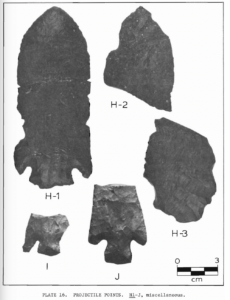The Denton Site? What is that?
The Denton Site, nestled discreetly on a levee in modern-day Quitman County, Mississippi, has emerged as a pivotal location for understanding the Archaic Period through its rich assortment of artifacts. This site has not only revealed a diverse array of projectile points but also provided crucial insights into the cultural dynamics and technological advancements of ancient inhabitants.
Historical Context and Archaeological Investigation
Initially brought to archaeological attention in 1969, the Denton Site faced imminent threat from land leveling activities. Prompted by reports of amateur surveyors, archaeologists from the Mississippi Department of Archives and History undertook a comprehensive survey to salvage valuable archaeological data. While portions of the site had been inadvertently leveled, efforts focused on understanding the buried midden’s age, cultural affiliations, economic patterns, and its relationship with surface remains. This investigation laid the groundwork for further detailed excavations and analyses.
Projectile Points: Classification and Characteristics
Central to the Denton Site’s archaeological significance are its projectile points, totaling 288 specimens cataloged to date. These artifacts vary widely in form and material composition, predominantly crafted from local chert in hues ranging from yellow and tan to brown, with notable exceptions like Fort Payne chert.

The classified specimens encompass 176 whole and broken points, each exhibiting unique characteristics. Among these, Denton Points stand out with their thick, crudely percussion-flaked surfaces, slightly convex blade edges, and stems typically one-fourth to one-third the length of the point. Measurements across 96 specimens reveal lengths from 43 to 89 mm and widths from 24 to 50 mm, showing the technological variability and potential uses of these points, whether as spearheads, dart points, or multi-functional tools.
Technological and Functional Variations
The Denton points display intricate technological modifications and functional adaptations. Many specimens show signs of edge smoothing, indicative of prolonged use, while narrower points exhibit evidence of resharpening, suggesting a sustained tool life and adaptation to changing needs. Notably, some points, such as Specimen D, exhibit characteristics hinting at secondary functions, possibly serving as drills or specialized tools within the community.
Heat Treating at the Denton Site

The study conducted at the Denton Site in Quitman County, MS, reveals that heat treating, a method involving controlled heating to alter lithic (stone) materials, was not widely employed during the early phases of occupation. Analysis of surface lithic assemblages from the Middle Archaic period consistently shows low percentages of heat-treated artifacts, averaging 15.16%. In contrast, Late Archaic projectile points display a slight increase in heat-treating efforts, reaching 21.11%. Identified by their waxy, lustrous surfaces often in red or orange hues, heat-treated artifacts were notably more prevalent among broken projectile points than whole ones, implying potential weaknesses induced by heating contributing to breakage. However, only a small fraction of broken points exhibited transverse fractures directly linked to heating effects, suggesting that while heat treating may weaken points, it typically does not lead to significant breakage.
Additionally, while cores showed minimal evidence of heat treating, bifaces—often precursor tools—demonstrated higher percentages of heat treatment. This aligns with the notion that bifaces, selected for further refinement, were more likely subjected to heat treating than cores initially used for flake removal. The close percentage similarities between heat-treated whole and broken bifaces and points indicate that breakage in both categories likely stems more from functional use or technological processes than from heat-induced weakening.
While heat treating was not extensively practiced during Denton’s early phases, its selective application to bifaces and the observed patterns of artifact breakage provide valuable insights into the lithic technology and manufacturing practices of ancient inhabitants in Quitman County, MS.

Chronological and Regional Significance
Chronological assessments place Denton points in use before 3000 BCE, supported by radiocarbon dating and stratigraphic analysis from neighboring sites like Longstreet, Parrot, Gates, and Curtis Station. This places them within the Middle to Late Archaic periods of the Yazoo Basin’s prehistory. The presence of distinctive point types like Big Sandy, Cache River, and Dalton points further enriches our understanding of regional cultural interactions and technological exchanges during this epoch.
Conclusion
In conclusion, the Denton Site’s projectile points offer a nuanced window into the technological evolution, material preferences, and possibly diverse functions of prehistoric communities in Quitman County, MS. Their classification and detailed study not only shed light on ancient tool-making techniques but also underscore the cultural and chronological significance of the site within the broader southeastern United States. Continued analysis and comparative studies with other regional sites promise to further illuminate the lifeways and societal complexities of the Archaic Period inhabitants in this pivotal archaeological landscape.
Citations:
Mississippi Department of Archives and History. “The Denton Site.” Accessed July 8, 2024. https://www.mdah.ms.gov/sites/default/files/2020-04/AR-4.pdf.
Additional images courtesy of Adobe Stock
Read the previous article here:
Echoes of the Mississippi: Effigy Beads found at Poverty Point



















